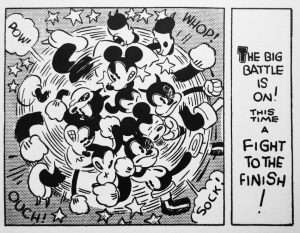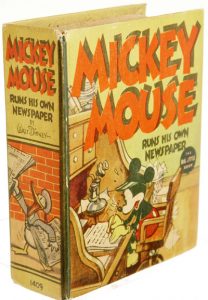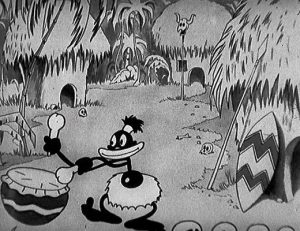
Suspended Animation #305
I interviewed Floyd Gottfredson in fall 1979 for an article, “The Mouse Man”, that I wrote in issue #6 of the Disney-oriented fanzine, The Duckburg Times.
Gottfredson was sometimes referred to as “The Mouse Man” because of his iconic work for decades on the Mickey Mouse comic strip but few remember he started as a Disney animator.

Floyd Gottfredson
Remember that this interview took place in pre-internet days and there were only a handful of books about Disney at all so very little information existed that today is common knowledge. In addition, I was pretty young so I really didn’t know what questions I should be asking and I was much more interested in animation than Disney comic strips.
I got the opportunity to interview Gottfredson because he lived nearby and my uncle had a friend who knew Gottfredson socially and was also a Mormon like Gottfredson. So as a birthday present because I was always so interested in all things Disney, my uncle was able to arrange for me to meet and talk with this very talented and kind artist who lived reasonably nearby.
With my small reel-to-reel tape recorder, I was able to record the conversation and painstakingly transcribed it and edited it.
Gottfredson: Looking for another job, I went to Vermont Avenue in Los Angeles, California, where all the film exchanges were and one of them had a one-sheet Mickey Mouse movie poster standing in front of it. As a projectionist in Utah, I had run all of Walt’s Oswald the Lucky Rabbit animated cartoons so I was familiar with the Disney name but I had never seen or heard of Mickey Mouse before.
“Out of curiosity, I went in and the fellow there and I started talking and he told me he had heard that Walt was going to New York the following week to look for artists. I lost no time in putting together my samples and rushing out to the Disney Studio which was then located on Hyperion Avenue. I figured I would get the jump on the fellows who might be applying in New York since I was already there in Los Angeles.
“Walt himself looked over my samples and asked me what sort of work I was interested in doing and I told him I wanted to do comic strips. Well, at that time, Disney wasn’t doing any comic strips. Walt was quite a salesman. He told me I didn’t want to get involved in doing comic strips because it was a rat race.
 “He said that the future would be animation and he was so convincing that I said, “Fine. Do you have any openings in animation?” And he said, “Sure, we’ll put you in as an in-betweener.”
“He said that the future would be animation and he was so convincing that I said, “Fine. Do you have any openings in animation?” And he said, “Sure, we’ll put you in as an in-betweener.”
“Then he said that he and Ub Iwerks were just beginning to put together a Mickey Mouse comic strip for King Features and that it would be good to have me around as a back-up man in case they needed some help.
“I went to work the following day, December 19, 1929. I was 24 years old and had been married for five years. I had been earning $65 a week as a projectionist and Walt was offering $18 a week but I took it because he had really convinced me that animation was the future. I did some free-lance cartooning on the side by mail and within eight months I was making more than I made as a projectionist.
“I only worked about four months in animation as an in-betweener. I did in-between work for Johnny Cannon and later Dave Hand and Wilfred Jackson. I even did a few in-betweens for Ub Iwerks.
“It was all work for the Silly Symphonies. Norm Ferguson and Dave Hand gave me a little piece of animation to do on Cannibal Capers (1930). It was a lion running out of the jungle and a cannibal beating on a drum. That was really the only animation I ever did but it worked out pretty well and I was just fascinated with animation.
“The Mickey Mouse comic strip debuted in January 13, 1930, with Walt doing the writing and Ub penciled them and an artist named Win Smith was doing the inking. After the first eighteen strips, Ub left and Win took over.
“King Features wanted continuity, that is to say, they wanted the strip to have a story and a plot because other strips like Sidney Smith’s The Gumps were very popular being “story strips”. Walt met with Win and told him he was going to take over the writing and Win who had a short fuse wasn’t going to be told what to do and so he quit. He came by my desk and said, “I think you’ve got a new job”.
“About a half hour later, Walt called me into his office and asked me whether I would like to take over doing the strip. By now I had become very interested in animation and was reluctant to change. I told Walt that he was right and that I would prefer to stay with animation. Well, Walt was quite a salesman. He told me to just take the strip for two weeks to give him some time to find another artist.
 “I wanted to help out so I agreed. After all, he had told me that part of my job was to be a possible back-up on the strip. At the end of a month, I wondered if he was really seriously looking for anyone. After two months, I began to worry that he might actually find someone because I was enjoying doing it and wanted to continue with it.
“I wanted to help out so I agreed. After all, he had told me that part of my job was to be a possible back-up on the strip. At the end of a month, I wondered if he was really seriously looking for anyone. After two months, I began to worry that he might actually find someone because I was enjoying doing it and wanted to continue with it.
“Nothing more was ever said about it and I continued to draw the Mickey daily strip for about forty-five and a half years until my retirement on October 1, 1975.
We tried to follow the spirit of the Mickey animated cartoons but because we were doing adventure stories we had to go beyond them. The animated cartoons had just a loose story structure where there could be a lot of gags building to a conclusion.
“That isn’t how stories are done in newspaper strips. We had to develop the characters more to help sustain the story. I loved doing these little adventures but keeping them as humorous as possible. Straight gags are too thin. Not enough meat to them. I think going back to gag-a-day was a step backwards and I think this was proved by the drop in popularity of the strip.
 “Walt himself set the precedent for borrowing ideas from the cartoons. The strip was influenced by the cartoons but also the fads and movies of the day. The Mad Doctor influenced the strip story “Mickey Mouse in Blaggard Castle”, although the mad professors in our story were modeled after a Boris Karloff movie I had just seen.
“Walt himself set the precedent for borrowing ideas from the cartoons. The strip was influenced by the cartoons but also the fads and movies of the day. The Mad Doctor influenced the strip story “Mickey Mouse in Blaggard Castle”, although the mad professors in our story were modeled after a Boris Karloff movie I had just seen.
“Mickey and the Seven Ghosts” was inspired by the animated cartoon Lonesome Ghosts. “Mickey Mouse Runs His Own Newspaper” was inspired by the gangster movies of the time like Scarface and Little Caesar.
“I tried hard to match the Mickey I was drawing for the newspaper strip with the Mickey of the films.
“Fred Moore was the fellow who really streamlined the mouse and some of the other characters. To me, the finest Mickey short cartoon that was ever made was The Nifty Nineties (1941) with Fred Moore’s design of Mickey. I’ve said this many times before but I think the best Mickeys ever done were by Fred Moore. I tried to imitate Fred but I don’t think anyone could ever copy his style.
“The animation department didn’t even know we existed. We were so small and shoved in a back corner that it was out of sight, out of mind I guess.
“Our salaries were never as high as the animators.

For more about Floyd Gottfredson, please look into Fantagraphics Books 10-volume series of Mickey Mouse comic strip reprints – edited by David Gerstein.



 Jim Korkis is an internationally respected animation historian who in recent years has devoted his attention to the many worlds of Disney. He was a columnist for a variety of animation magazines. With his former writing partner, John Cawley, he authored several animation related books including The Encyclopedia of Cartoon Superstars, How to Create Animation, Cartoon Confidential and Get Animated’s Animation Art Buyer’s Guide. He taught animation classes at the Disney Institute in Florida as well as instructing classes on acting and animation history for Disney Feature Animation: Florida.
Jim Korkis is an internationally respected animation historian who in recent years has devoted his attention to the many worlds of Disney. He was a columnist for a variety of animation magazines. With his former writing partner, John Cawley, he authored several animation related books including The Encyclopedia of Cartoon Superstars, How to Create Animation, Cartoon Confidential and Get Animated’s Animation Art Buyer’s Guide. He taught animation classes at the Disney Institute in Florida as well as instructing classes on acting and animation history for Disney Feature Animation: Florida.




















































I think Floyd Gottfredson’s animation in “Cannibal Capers” is the best in the film, comparing favourably to that of Ben Sharpsteen.
“The Nifty Nineties” is notable not only for Fred Moore’s design of Mickey Mouse, but also for Fred Moore’s design of… Fred Moore! That cartoon is packed with Disney studio in-jokes, from the advertisements in the vaudeville theatre to the cornball humour of comedians “Fred and Ward [Kimball], two clever boys from Illinois”. That would have gone completely over the heads of audiences in 1941, but we Disney fans can appreciate it today — thanks in no small measure to your chronicling the anecdotes of studio personnel over the years. That must have been one heck of a birthday!
Off topic for a moment…we have just learned that Christopher Plummer, narrator of such legendary animated series as “The World Of David The Gnome” and “Madeline”, passed away just a few hours ago, at 91. He was a true legend, his voice not only entertained kids, but adults as well. Best known for SOUND OF MUSIC and deservingly won his Oscar several years back. And yes, he was a voice in the original AN AMERICAN TAIL.
The only offspring of this Canadian legend is actress/daughter Amanda Plummer (PULP FICTION)…we should all send our condolences to her today.
Thank you, Christopher. May you live on in the Heavens of Animation, amongsted other great voice legends as Mel Blanc, Walt Disney, Linda Gary, Wayne Allwine, and others.
That was so interesting. Thank you for posting. I’m a huge fan of Floyd’s work on the Mickey Mouse strip. He did such amazing work.
Gottfredson’s Mickey Mouse strip is THE quintessential Mickey Mouse to me. Especially the pie eye version right before he gained pupils in which I wished NEVER happened. I had been a Mickey Mouse fanatic my whole life and it wasn’t until I stumbled upon the Mickey Mouse Joins The Foreign Legion that my mind was blown. Having Mickey be an Indiana Jones type of character totally forever revolutionized my vision of Mickey to the point that as much as I love the animated shorts, it was a major disservice to Gottfredson gave Mickey. I really wished Walt would have expanded on this in the vein of Tin Tin, but not too closely. To this day I wish someone could continue making something compelling and adventurous like this with this character instead of being mostly a company Icon that he is today. Although I have to say I really like a zany shorts they are doing with Mickey and the gang currently. I still feel he could wear multiple hats today like he has before.
I own the entirety of the Gottfredson collection released from Fantagraphics and they are one of my highest treasures.
“To this day I wish someone could continue making something compelling and adventurous like this with this character instead of being mostly a company Icon that he is today.”
Modern Mickey comic creators like Andrea “Casty” Castellan are making some great Mickey adventure stories today. You can find some of them in IDW’s “Mickey Mouse – Timeless Tales” books, collecting the Mickey Mouse comic book issues that IDW published in 2015-2018. Previous Disney Comics publisher Boom Kids also released some Casty comics, including “Mickey Mouse: The Wold to Come” and “Mickey Mouse on Quandomai Island”.
Chuck– Disney tried to do a massive promotional campaign called Perils of Mickey in 1993-1994 to try to revitalize the brand of Mickey Mouse on his 65th birthday as an adventurer using artwork inspired by Gottfredson. There was a sleeping bag, beach towels, colorforms, puzzles, coloring books, storybooks, rubber stamps, Viewmaster reels, puffy stickers, Tiger Electronics handheld LCD, limited edition Lionel train Hi-cube box cars, school back pack, lunch box, toys, bendable figures, PVC “talking Mickey: figures, key chain, water bottle, buttons, posters, clothing (like a varsity jacket) and much more. I would recommend you try to find the Nabisco Perils of Mickey Fun Book that featured three two-page comic stories done it the style of Gottfredson and continuing three of his famous comic strip stories.